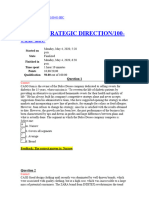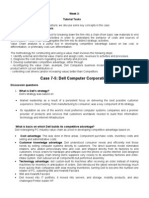0 ratings0% found this document useful (0 votes)
777 viewsLoblaw - Wal Mart Case
Loblaw - Wal Mart Case
Uploaded by
luckyroberthoThis document provides an overview of Loblaw, Canada's largest grocery retailer. It discusses Loblaw's mission, history of acquisitions, corporate strategy focused on private labels and distribution, and SWOT analysis. It also covers the threats posed by Walmart's market entry and Loblaw's 2007 review to lower prices, improve inventory, and differentiate store formats in response to increasing competition.
Copyright:
© All Rights Reserved
Available Formats
Download as DOCX, PDF, TXT or read online from Scribd
Loblaw - Wal Mart Case
Loblaw - Wal Mart Case
Uploaded by
luckyrobertho0 ratings0% found this document useful (0 votes)
777 views4 pagesThis document provides an overview of Loblaw, Canada's largest grocery retailer. It discusses Loblaw's mission, history of acquisitions, corporate strategy focused on private labels and distribution, and SWOT analysis. It also covers the threats posed by Walmart's market entry and Loblaw's 2007 review to lower prices, improve inventory, and differentiate store formats in response to increasing competition.
Original Description:
Loblaw - Wal Mart case
Original Title
Loblaw - Wal Mart case
Copyright
© © All Rights Reserved
Available Formats
DOCX, PDF, TXT or read online from Scribd
Share this document
Did you find this document useful?
Is this content inappropriate?
This document provides an overview of Loblaw, Canada's largest grocery retailer. It discusses Loblaw's mission, history of acquisitions, corporate strategy focused on private labels and distribution, and SWOT analysis. It also covers the threats posed by Walmart's market entry and Loblaw's 2007 review to lower prices, improve inventory, and differentiate store formats in response to increasing competition.
Copyright:
© All Rights Reserved
Available Formats
Download as DOCX, PDF, TXT or read online from Scribd
Download as docx, pdf, or txt
0 ratings0% found this document useful (0 votes)
777 views4 pagesLoblaw - Wal Mart Case
Loblaw - Wal Mart Case
Uploaded by
luckyroberthoThis document provides an overview of Loblaw, Canada's largest grocery retailer. It discusses Loblaw's mission, history of acquisitions, corporate strategy focused on private labels and distribution, and SWOT analysis. It also covers the threats posed by Walmart's market entry and Loblaw's 2007 review to lower prices, improve inventory, and differentiate store formats in response to increasing competition.
Copyright:
© All Rights Reserved
Available Formats
Download as DOCX, PDF, TXT or read online from Scribd
Download as docx, pdf, or txt
You are on page 1of 4
At a glance
Powered by AI
The key takeaways are that Loblaw is Canada's largest supermarket chain but is facing challenges like declining profits and increasing competition. It is looking to simplify operations, innovate, and grow under a new business plan.
Loblaw's mission is to be Canada's best food, health, and home retailer by exceeding customer expectations through innovative products at great prices. It is committed to a strategy of simplifying operations, innovating, and growing.
Some of Loblaw's corporate strategies include creating private labels, consolidating distribution centers, closing unprofitable stores, maximizing its fleet usage, implementing uniform pricing, and standardizing store designs.
Daftar Isi
- Loblaw mission and vision statement
- Loblaw history
- Corporate strategy
- Industry overview
- SWOT analysis
- Wal-Mart Market Entry
- February 2007: 100-day review
- Summary
- Discussion Question
- References
Loblaw mission and vision statement
Loblaws mission is to be Canadas best food, health, and home retailer by exceeding customer
expectations through innovative products at great prices.
Loblaw is committed to a strategy developed under three core themes: Simplify, Innovative and
Grow.
Loblaw history
Loblaw was acquired by George Weston Ltd.
- Loblaw was built as a food empire through the purchase of grocery manufacturers, retails
and wholesalers.
- Credited with inventing premium private brands in North America.
- In 2005, Loblaw was the largest supermarket chain in Canada, with an estimated market
share of 34,9%.
- In 2008, Loblaw has 609 corporate and 427 franchised stores in every province and territory
in Canada (21 banners).
- Loblaws Presidents Choice and name control brands are the 1# consumer packaged good
brands by sales in Canada.
Corporate strategy
Creation of private labels
Consolidated of distribution centers
Closure of unprofitable stores
Maximized the use of Loblaws fleet
Uniform pricing strategy
Standardized store design
Renegotiated union contracts
Introduction of general offerings
Industry overview
- Canadian supermarket industry was valued at $73 billion in 2006.
- The grocery business was les fragmented, more competitive, multicultural and dominated
by nation companies.
- Canada has a well-developed discount grocery sector with very high standards.
- The Provinces of Ontario is a key market in Canada and the biggest market for Loblaw.
Ontarios sales declined 4.3% in 2006.
- Although sales in 2006 grew 2.49%, the growth was slower than the traditional year-to-year
increase of around 4.8%.
- New stores are increasing the average size of supermarkets in Canada.
- National and regional chains are getting a wider range of store innovations and an increased
spotlight on private labels.
SWOT analysis
Strength
- Strong brand name
- Position of market share sales number continue growing
- 7000 private-label products (No Name and Presidents choice)
- Presidents organic product
- Presidents choice bank and its loyalty program
- Large amount of fixed assets versus low amount of debt
- Economy of scale and large knowledge and experience in Canadian market.
- Wide geographic coverage (all Canadian provinces)
- Social responsibility initiatives, close to the community.
Weakness
- Operating margin dropped to 1% in 2006.
- Return on average total assess of only 2.30% in 2006
- Stores are underperforming
- Complicated corporate structure and weak management
- Plagued with problems in its distribution systems: broken buyer-supplier relationships,
delayed delivering goods, out of stocks.
- Loblaw is not doing fresh food as well as the others are right now
- Customers accustomed to prices driven by regular sale promotion
- Customers find difficult to navigate the superstores
- Lack of experience managing general merchandise inventory
- 21 banners
Opportunities
- New management team and dew business plan
- Commitment to strategy: Simplify, Innovative, Grow
- Growing its discount segment, becoming the low-price leader
- Openings to exploit emerging new technologies
- Proven product innovation capabilities
- Large on financial resources to grow the business and pursue promising initiatives
- Four-year contract with unions and elimination of 20% of its administrative workforce
- Lack of customer awareness about general merchandise deep discount pricing strategy
- Joe Fresh Style line of clothing
Threats
- Goodwill is continuously dropped in value
- Market/book ratio has been decreasing since 2002
- Intense competition
- Major Union problems
- Grocery sales are growing slower than others years average
- Canadian market is attracting foreign investors
- Wal-Mart experience in global market has continually pushed its general merchandise
dominance forward while developing its food business.
Conclusions
- Although the Loblaw faced significant hurdles, the company has an attractive set of strength
and resources to restore its profitability and growth.
- We have identified as alarming weak, its problems with distribution system and tolerated
poor management. A retailed stores distribution system and management are key success
factors.
- The major threat is that competitors are growing stronger while Loblaws consumer
satisfaction is decreasing due to the company poor performance.
- Loblaws best opportunity is to capitalize its experience on food market. Loblaws
commitments to simplify, innovate, and grow under the application of a new business plan
is the best opportunity that the company has to be a front-runner again.
Wal-Mart Market Entry
- Wal-Mart poses a serious threat to other grocers
a. Economies of scale and scope
b. Everyday low pricing
c. Supplier influence
d. State-of-art distribution system
- Wal-Mart built a super-centers and rapid expansion forthcoming
a. In 2007 groceries accounted for 31% of total sales
February 2007: 100-day review
We are not delivering the right value for money and we are not getting the credit with the
customer for investments that we do make, said chairman Galen Weston Jr.
Proposed actions by executing and analysts:
- Clear out excess inventory and improve stocking
- Strong offering of private labels, de-emphasize national brands and eliminate redundant
sizes
- Reduce space allocated to general merchandise. Devote more are to food or reduce the size
of stores
- Lower prices for selected items to retain its customers
- Improved differentiation between the smaller conventional Loblaw supermarkets and the
larger discount outlets
- Reconstruction of the famous Maple leaf Gardens in downtown Toronto
Summary
Loblaw has begun to reorganize its business strategy however it is evident that change is imminent.
References
- Canadian Council of Grocery Distribution (CCGD)
http://www.ccgd.ca/home/en/index.html
- Loblaw Companies Limited
http://www.loblaw.com/
- Thompson, A.A.Jr., Stricland, A. J. III, & Gamble, J. E. 2009. Crafting & Executing Strategy:
The Quest for Competitive Advantage: Concepts and Cases, Sixteenth Edition. New York,
N.Y.: McGraw-Hill/Irwin
You might also like
- Restaurant MouDocument9 pagesRestaurant MouVivek Kumar Shukla100% (1)
- Internationalisation Process of CocaDocument4 pagesInternationalisation Process of CocaJan Sheer ShahNo ratings yet
- ENGG4104 - Assignment 3 - 46129286Document4 pagesENGG4104 - Assignment 3 - 46129286saif haqueNo ratings yet
- Marketing Management-II Case Analysis: Eureka Forbes LTD: Managing The Selling Efforts (A)Document4 pagesMarketing Management-II Case Analysis: Eureka Forbes LTD: Managing The Selling Efforts (A)Kalai VaniNo ratings yet
- Hemang Chauhan P40015 OSD AssignmentDocument1 pageHemang Chauhan P40015 OSD AssignmentMegaAppleNo ratings yet
- Cor STR CaseDocument9 pagesCor STR CaseRupok AnandaNo ratings yet
- SWOT Analysis: Singapore Airlines Use of Competitive Advantage For Growth (2018)Document3 pagesSWOT Analysis: Singapore Airlines Use of Competitive Advantage For Growth (2018)ashNo ratings yet
- Group 6 Operation Management ProjectDocument28 pagesGroup 6 Operation Management ProjectshahkrunaNo ratings yet
- Marketing PresentationDocument9 pagesMarketing PresentationAmmar khanNo ratings yet
- Kasus Bab 6 - Loblaw Companies LimitedDocument3 pagesKasus Bab 6 - Loblaw Companies LimitedYan_Chii0% (1)
- Integrated Marketing Communications: Sales PromotionDocument13 pagesIntegrated Marketing Communications: Sales PromotionsurbhiNo ratings yet
- Procter and GambleDocument11 pagesProcter and GambleRemya sreeNo ratings yet
- Marketing Management Case StudiesDocument7 pagesMarketing Management Case StudiesBo RaeNo ratings yet
- Case Analysis - Jess WesterlyDocument5 pagesCase Analysis - Jess WesterlyNEHA JENA IPM 2018 BatchNo ratings yet
- Strategic Management Exam JaimeDocument21 pagesStrategic Management Exam JaimeScribdTranslationsNo ratings yet
- Loblaw'sDocument17 pagesLoblaw'ssusmadhakal100% (2)
- Sealed Air Diversey Merger Acquisition Presentation Slides Deck PPT June 2011Document40 pagesSealed Air Diversey Merger Acquisition Presentation Slides Deck PPT June 2011Ala BasterNo ratings yet
- Brand Name: Cadbury Dairy Milk Product Category: ChocolateDocument15 pagesBrand Name: Cadbury Dairy Milk Product Category: ChocolatePRITEE100% (1)
- Andrea Jung and The Turnaround of Avon ProductsDocument8 pagesAndrea Jung and The Turnaround of Avon Productsnani15031987No ratings yet
- Jack WelchDocument13 pagesJack Welchnitin_yogeshNo ratings yet
- SG Cowen: A Case StudyDocument7 pagesSG Cowen: A Case StudyParv PandeyNo ratings yet
- Darft4-A Critique of The Discipline of TeamsDocument5 pagesDarft4-A Critique of The Discipline of TeamsstarcatcherNo ratings yet
- Case Study Dell CompanyDocument2 pagesCase Study Dell CompanyNando EriawanNo ratings yet
- Does IT Payoff? Strategies of Two Banking Giants: Submitted By: Group 4, Section BDocument5 pagesDoes IT Payoff? Strategies of Two Banking Giants: Submitted By: Group 4, Section BNeha Bhomia GuptaNo ratings yet
- RhytmDocument25 pagesRhytmJulia Ortiz0% (1)
- Coke Assignment 2Document19 pagesCoke Assignment 2Yasser Imam FaizNo ratings yet
- McDonalds SWOT Analysis 2013Document3 pagesMcDonalds SWOT Analysis 2013Smart Ed100% (1)
- P&G Japan SK-II Globalization ProjectDocument24 pagesP&G Japan SK-II Globalization Projectfawad_hussain_286% (7)
- Ajeeth Pingle Brand Extention PlanDocument17 pagesAjeeth Pingle Brand Extention PlanAjeeth PingleNo ratings yet
- PGMB1950 Vaibhav Session9Document6 pagesPGMB1950 Vaibhav Session9vaibhav chaurasiaNo ratings yet
- Business Strategy Mid Term Short AnswersDocument4 pagesBusiness Strategy Mid Term Short AnswersMonil ChhedaNo ratings yet
- Executive Summary: Problem DiscussionDocument5 pagesExecutive Summary: Problem Discussionmyservices 786100% (1)
- Coca Cola - Case StudyDocument8 pagesCoca Cola - Case StudyJuwairiya JavedNo ratings yet
- Thomas Green L05 Case StudyDocument6 pagesThomas Green L05 Case StudyGreggi RizkyNo ratings yet
- Sec A Group 9 When A New Manager StumblesDocument13 pagesSec A Group 9 When A New Manager StumblesKpvs NikhilNo ratings yet
- My Kind of CakesDocument9 pagesMy Kind of CakesFahad AlMutairiNo ratings yet
- Annual Report - FinalDocument25 pagesAnnual Report - Finalapi-460344150No ratings yet
- New Year Eve CrisisDocument6 pagesNew Year Eve CrisisManoj Kumar MishraNo ratings yet
- MysticMonkCoffeeCaseStudy TravisHuberDocument7 pagesMysticMonkCoffeeCaseStudy TravisHuberTravisJohnHuber50% (2)
- C11SH+Pre Released+Case+Study+MaterialDocument4 pagesC11SH+Pre Released+Case+Study+MaterialAfshan NazirNo ratings yet
- Financial Management E BookDocument4 pagesFinancial Management E BookAnshul MishraNo ratings yet
- Marketing Strategies of AlmaraiDocument6 pagesMarketing Strategies of Almaraiنواف القحطاني100% (1)
- Zero WageDocument2 pagesZero WageRubak Bhattacharyya100% (1)
- Virgin Mobile USA Pricing For The Very First TimeDocument6 pagesVirgin Mobile USA Pricing For The Very First TimeAli_Asad_1932No ratings yet
- Worington Health CareDocument2 pagesWorington Health Carercbcsk cskNo ratings yet
- Strategic ManagementDocument4 pagesStrategic ManagementA CNo ratings yet
- Chapter-1 OPeration ManagementDocument2 pagesChapter-1 OPeration ManagementAyman Fergeion100% (1)
- Google Diversification StrategyDocument2 pagesGoogle Diversification Strategyli100% (1)
- Recipe For Success: Case AnalysisDocument2 pagesRecipe For Success: Case AnalysisAshwin NagarNo ratings yet
- SKIIDocument5 pagesSKIIvkiprickinsNo ratings yet
- Amazoncoms European Distribution Strategy PDFDocument6 pagesAmazoncoms European Distribution Strategy PDFrohansahniNo ratings yet
- Strategy and Competitive Advantage in Diversified CompaniesDocument61 pagesStrategy and Competitive Advantage in Diversified CompaniesAnum ImranNo ratings yet
- John Keells Case StudyDocument4 pagesJohn Keells Case StudyheshanNo ratings yet
- BLC 201 Assignment Intro Logistics SCM Sep 2021 - McdonaldDocument5 pagesBLC 201 Assignment Intro Logistics SCM Sep 2021 - McdonaldHf CreationNo ratings yet
- (RKC) - Project Managment Leadership and Skills - Assessment BriefDocument10 pages(RKC) - Project Managment Leadership and Skills - Assessment BriefAhmad Al-ZabatNo ratings yet
- Dynamics Capabilities Modelo PPT MomoDocument44 pagesDynamics Capabilities Modelo PPT MomoluanasimonNo ratings yet
- IMChp 1Document7 pagesIMChp 1Mona A HassanNo ratings yet
- Leadership The Ford MotorDocument12 pagesLeadership The Ford Motoralexos2012No ratings yet
- ManagementDocument5 pagesManagementHassan AwaisNo ratings yet
- Growth Strategy Process Flow A Complete Guide - 2020 EditionFrom EverandGrowth Strategy Process Flow A Complete Guide - 2020 EditionNo ratings yet
- A B C D E: The Students Are Playing in The ForestDocument16 pagesA B C D E: The Students Are Playing in The ForestToyStoryNo ratings yet
- Heavy Breathing Huff Huff Damnit, Where Are They? I Better Have To Find Those Scoundrels!!Document7 pagesHeavy Breathing Huff Huff Damnit, Where Are They? I Better Have To Find Those Scoundrels!!Gabrielle Joyce MabutasNo ratings yet
- GMP Training SlideshowDocument54 pagesGMP Training SlideshowcavanacngNo ratings yet
- Alizonne Recipes1Document54 pagesAlizonne Recipes1amcm69No ratings yet
- Best Home Appliances Company in Cuttack OdishaDocument20 pagesBest Home Appliances Company in Cuttack Odishaalok jyotiNo ratings yet
- Vietnam Food & Beverage IndustryDocument55 pagesVietnam Food & Beverage Industrybuihongmai171090No ratings yet
- Un - Bhs. Inggris Klinik Pendidikan Global Mandiri: Kevin@yahoo - Co.idDocument11 pagesUn - Bhs. Inggris Klinik Pendidikan Global Mandiri: Kevin@yahoo - Co.idbudinugroho87No ratings yet
- Breadtalk KimEngDocument29 pagesBreadtalk KimEngCipto WibowoNo ratings yet
- PepsiDocument107 pagesPepsiJuan Pablo Albarracin67% (3)
- Introduction To Operations Management 1Document48 pagesIntroduction To Operations Management 1Safar ppNo ratings yet
- Customer Sales Report by Product by Invoices: Pt. Jensina Atara Sentosa, Cirebon (Nestle Profesional)Document5 pagesCustomer Sales Report by Product by Invoices: Pt. Jensina Atara Sentosa, Cirebon (Nestle Profesional)Admin CirebonNo ratings yet
- Excel and Excel QM ExamplesDocument84 pagesExcel and Excel QM ExamplesVishal KumarNo ratings yet
- Synopsis of Bakery IndustryDocument2 pagesSynopsis of Bakery IndustryRupam50% (2)
- Market Segmentation, Target Market and Consumer Profiling of Pizza Hut PakistanDocument6 pagesMarket Segmentation, Target Market and Consumer Profiling of Pizza Hut PakistanReader87% (15)
- Kitkat Sample ReportDocument7 pagesKitkat Sample ReportJayesh GargNo ratings yet
- PH Importers For BOC Suspension - Feb3Document17 pagesPH Importers For BOC Suspension - Feb3PortCalls0% (1)
- Group 2 Feasibility Study PacioliDocument55 pagesGroup 2 Feasibility Study PacioliJcNo ratings yet
- Learning Activity 3.1Document2 pagesLearning Activity 3.1Rose An Mae BuenaflorNo ratings yet
- Chapter 1: The Problem and Its BackgroundDocument16 pagesChapter 1: The Problem and Its BackgroundSci CalNo ratings yet
- Conjoint AnalysisDocument44 pagesConjoint Analysissaumyagargi190878No ratings yet
- Rice Mill: Description of Rice Milling OperationDocument6 pagesRice Mill: Description of Rice Milling OperationsarveshnemaNo ratings yet
- Business Management May 2017 Case StudyDocument4 pagesBusiness Management May 2017 Case StudybenniNo ratings yet
- Fresh Fruit ReceptionDocument2 pagesFresh Fruit ReceptionhaysnamripNo ratings yet
- Daily Work Journals PDFDocument12 pagesDaily Work Journals PDFapi-335752287No ratings yet
- HYGEIA INTERNATIONAL AND APG - Rev1Document5 pagesHYGEIA INTERNATIONAL AND APG - Rev1Mikaela PadillaNo ratings yet
- Office-Worker Retail Spending in A Digital Age - ICSCDocument84 pagesOffice-Worker Retail Spending in A Digital Age - ICSCDavid FitzpatrickNo ratings yet
- Fraude Alimentario BRC IFS: en Los Esquemas de Certificación eDocument12 pagesFraude Alimentario BRC IFS: en Los Esquemas de Certificación ePaolaJaqueMartínezNo ratings yet
- Matriz Dofa: Estevia: Javier López - Melissa Ordoñez - Sebastián Varela y Andres SánchezDocument7 pagesMatriz Dofa: Estevia: Javier López - Melissa Ordoñez - Sebastián Varela y Andres SánchezMelissaNo ratings yet

























































































